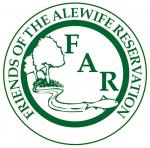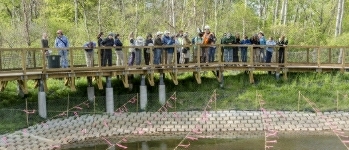Speaking most of the afternoon with the engineers who have finally cut off the CSO (Combined Sewer Overflow) at the FP rotary with much personnel the last few days. This has been a 15 year process, and one of the engineers noted it was a xmas present to him after working on it those many years. The sewer wall at the Rotary that separated sewage from storm water a few days ago from Huron area exists no longer which means cleeaner storm water , and MWRA sewer has been shut off permanently, and only storm water will head to the new wetlands forebay and wetlands and the outfall behind the circular T. "Grit pits" and "hooded catch basins" will be increased removing more residue in the pipes. This will need to be carefully watched, I suggest since the sewer separation in the Huron Av. district is now complete. The results can be seen soon by SKIDA water testing which is located at the Cambridge Park Dr.entry to the Reservation between the new FUSE building and Amgen walkway into the storm water wetlands. We were supposed to see the testing stations in 2013 as was noted.
Also Fawcett St. will be tied into that pipe to the wetlands, so we would should see the water quality results soon to note improvement there. Any proposed development will need to quadrouple its sewage holdings from what the area does now, with stringent storm water requirements which could prevent over-development. We must see no permits given until the MS4 Federal storm water standards are in in January most likely. Developers foaming to get permitted should wait, and citizens should be alerted to this.
Also, note that the CAM 004 behind the circular T entry is permanently cut off arising from the Federal Court order from the 80s and a Variance given by MWRA Fred Lasky and Mr. Varney of US-EPA at that time which allowed a long extension of the sewer separation ( CSO) deadline (national) till now. More variances, however, are planned until 2020. Reasons for more Cambridge variances will need public hearings from US-EPA.
It seems that none of the municipalities are taking responsibility for river flow bacteria, cynobacteria and e-coli, etc. Most of the challenge is in "Little River", formerly Menotomy River, named after Native American history of Cambridge, whose name is rarely used (substituting "Alewife Brook"). but is the victim of constant sewage flows which scar and destroy our healthy river ecosystems, and our access to Little River as a wonderful recreational resource, not to mention the great array of wildlife that reside there and require healthy habitat, and not to mention the health and safety of residents along the Mystic River watershed who are in danger of contamination if they go near the river during discharges, now less frequently. Report cards of D- Cambridge Little River, and F for Belmont's Winn Brook/Little POnd indicate that our "regionalism" needs to work better. The new Storm Water Committee in Belmont has the right idea, but is not able to do much it seems. Together, they could pool resources. Isn't it enough both municipalities gave away our only small river floodplain forest of over 700 trees which may well hurt us as climate continues to change with greater precipitation of over 50 percent says our hydrologist.
Ellen Mass
President
Friends of Alewife Reservation
Ellen,
Completion of the CAM004 Sewer Separation project by Cambridge marks the end of the project milestones in the current federal court order. The court schedule also requires MWRA to file an annual CSO progress report by March 16, 2016, commence a region-wide CSO performance assessment by January 2018, and complete the assessment and file an assessment report by December 2020. We expect to be working with EPA and DEP this winter and spring to scope out the performance assessment and to obtain an extension to the Charles River and Alewife Brook/Upper Mystic CSO variances for another 3-year period, to 2019. I expect there will be a public comment period and public hearing on these this summer.
As for the Huron/Concord stormwater flows now draining to the Alewife Wetland instead of flowing into the sewer system, Cambridge performed a rigorous water quality testing program to ensure the absence of sanitary contamination in the stormwater. Cambridge also has installed measures, including grit chambers in the storm drain system and the forebay ahead of the wetland, to control stormwater sediments from entering the wetland. It will take some time to monitor long-term changes, both in the wetland and in the Little Alewife Brook.
David,
Some of us involved would like to know how to trace the Little River water quality projected improvements, during such a tightly required federal assessment schedule as you present for MWRA through 2019.
Public Hearings and continuous information are critical to this process. If you are saying leave us alone until 2019, and we'll do our best but a low water quality status may still be with us in Little River, but Variance could delay critical clean up, as we lose animals at the storm water wetland and sewage is still heavy in Little River from Belmont and Cambridge (?). When will the 85 percent improvement happen? I don't ;think you will find a willing public that will feel comfortable with major cleanup delays in our sphere of influence as environmental minded groups, neighbors and visitors.
Please let us know the 9 points of concern which require full federal assessment while this federal Variance or 2 or 3 variances allow much extended time to delay critical environmental protection goals of this watershed.
Congratulations on the 15 year successful CSO separation at Fresh Pond Rotary which will improve water discharge to the Forebay, and also the elimination of 004 to LIttle River we are told. (verified after your testing for a while). You well explained that the storm water wetland at the forebay on Cambridge Park Drive will receive regular flows from Fresh Pond separated storm water which have brand new "grit pits" and "catch basins" to remove sediments.
We know of no other storm water/sewage outfalls on LIttle River, except cam002 adjacent to Little River Alewife T car access bridge from Route 2, and cam401 close to Passenger Pickup across the street at west end of pharmaceutical garage where storm water and some CSO's will continue, but on much smaller scale now that the CSO has been shut off at Fresh Pond; and from back flow high rain/snow water events. Perhaps there will be no sewage from the newly created cam401, but do not know that.
So why are these multiple Fed.Variances needed in the future both for you and for the city of Cambridge? Most of us, especially neighbors and environmentalists, are opposed to 2500 more developers' housing units going up on the Quadrangle which remains a floodplain area according to our federal maps, no matter how advanced the city planning is along those lines, to be built before the River conditions are safe (and should be restored) for animals and people, insects, native plants, birds and amphibians, and for flood retention. Tax dollars are also important, but our health and safety must be more of city priority because the crowded cities require it.
Dangers are great if system is overtaken with weather, and thus, toxins and high bacteria counts (EPA shows intolerable bacteria counts in Cambridge) which are brought into our soils and properties with normal inundation. To be forced, for safety reasons, to deny recreational and standard of living access to the river for years to come should also be a vital consideration.
My group of Friends fully understands that there are different municipal and state entities responsible for these various and differentiated river cleanup tasks and high costs in Little River and further downstream in Alewife Brook with towns of Arlington, Somerville and Medford, i.e. that MWRA is only one such entity. We expect US-EPA and City of Cambridge to have multiple Hearings (not one mid-summer hearing) hopefully in March.
Please correct any misunderstandings. Thank you MWRA and City again for lessening the bacteria toxins in our Upper Mystic Basin sub-watershed and thus our Harbor and Ocean. And for using our tax dollars wisely to do so, we trust. But the climate future has some ominous signs for overtaxing our existing system in much more serious ways as we are only 5 feet above sea level at Alewife.
Ellen Mass, Friends of Alewife Reservation
- Home
- Directions
- FAR Wildlife Blog
- Calendar
- News
- Donate Now
- Get Social!
- Storm Water Wetlands
- Plants and Restoration
- Photos
- Videos
- About & Projects
- Master Plan for Alewife
- Archive
- Newsletters
- Contact
 Presentation Spotlighting Alewife Reservation
Presentation Spotlighting Alewife Reservation
 Follow us on Twitter
Follow us on Twitter
 Like us on Facebook
Like us on Facebook
 Follow us on Instagram
Follow us on Instagram
Forward our web address to a friend!
- An Urban Gem - Alewife Reservation Nature Preserve
- Envisioning The Silver Maple Forest
- History and Policies of Cambridge, Belmont, and DEP
- Storm Water Wetlands
- Friends of Alewife Reservation brochure
(front, back) - Technical Analysis of Upper Alewife Basin
- Watershed: An Excursion in Four Parts
- The River Is A Restless Spirit: Life in the floodplain forest
-
Assessment of Silver Maple forest for DEP Adjudicatory hearings and
Patrick Fairbairn, author of the Assessment - Community Native Garden Flora
The
Alewife Reservation
is a unique natural resource for the communities of Belmont, Arlington and Cambridge
and home to hundreds of species, including hawks, coyotes beavers, snapping turtles, wild turkeys and muskrats,
the reservation is a unique natural resource for the community.
Historical information (Powerpoint)
Friends of Alewife Reservation works to protect and restore this wild area and the surrounding area for the water quality, native plants, animals and over 90 bird species with paths for walking, running and biking, recreation, and for classroom education and research. We regularly steward and preserve the Reservation area for wildlife and for the enjoyment of present and future generations.

(video)
By-Laws
About Friends of Alewife Reservation
Statement of Purpose
Citizen Forester newsletter archive
The Birds of the Cambridge Region of Massachusetts

by William Brewster 1906
Nuttal Ornithological Society
Biodiversity Study of Alewife Reservation Area: Species, Habitat, Ecosystems

Inventories by David Brown, wildlife assessor (2003, 2004.) Published by and available from FAR for $10. Write or call for your copy. (sample)
Updated Dave Brown Inventories (2008, 2010)
Inventories of Alewife Reservation Wetland Plants by Walter Kittredge, Botanist (2013)

